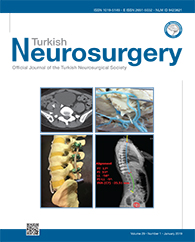2Gaziantep Medical Park Hospital, Neurosurgery Clinic, Gaziantep, Turkey
3Adana Numune Training and Research Hospital, Department of Neurosurgery, Adana, Turkey DOI : 10.5137/1019-5149.JTN.22658-18.2 AIM: To present the results of vertebroplasty for treating thoracolumbar burst fractures without neurological deficit.
MATERIAL and METHODS: Twelve patients (aged ≥65 years) with thoracolumbar fractures but without neurological deficits underwent vertebroplasty. In all fracture cases, the anterior and middle columns of the vertebrae were affected and the canal was mildly compressed. To assess the clinical symptoms and the effects of the procedure, patient mobility and pain were assessed prior to the procedure and at 1 day and 3 months after the procedure.
RESULTS: Improvements in pain and mobility were observed immediately after vertebroplasty in all patients. These results were observed for 3 months. Significant improvements were also noted at 1 day and 3 months after vertebroplasty. Pain was reduced by at least 4 levels after 3 months. No co-morbidities were observed. However, computed tomography revealed polymethylmethacrylate leakage through the endplate fracture site into the disc space or paravertebral space in four vertebrae and minimal intracanal leakage through the fracture line in one patient.
CONCLUSION: Vertebroplasty is assumed to be contraindicated in patients with osteoporotic thoracolumbar fractures with posterior body involvement. However, this procedure was successfully performed to safely treat such fractures without causing neurological deficits. Percutaneous vertebroplasty may be an alternative method for treating thoracolumbar burst fractures that prevents major surgical complications. Moreover, it helps patients achieve early mobilization and pain relief.
Keywords : Middle column, Percutaneous vertebroplasty, Posterior wall, Spinal fracture




